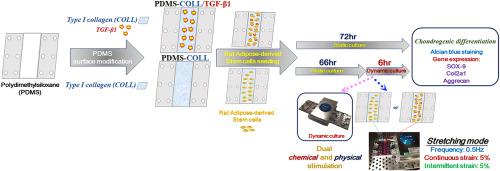Journal of the Mechanical Behavior of Biomedical Materials ( IF 3.3 ) Pub Date : 2020-08-27 , DOI: 10.1016/j.jmbbm.2020.104062 Shen-Jui Tseng,Chia-Ching Wu,Chi-Hui Cheng,Jui-Che Lin

|
The adipose-derived stem cell has been used in various regenerative medicine research due to its multiple differentiation capabilities. Developing a stable and quick approach for the differentiation of stem cells is a critical issue in tissue regenerative field. In this investigation, rat adipose-derived stem cells (rADSCs) were seeded onto the type I collagen/transforming growth factor β1 (TGF-β1) immobilized polydimethylsiloxane (PDMS) substrate and then combined with short term dynamic stretching stimulation (intermittent or continuous stretching for 6 h) to induce the rADSCs chondrogenesis differentiation using the induction medium without growth factors added in vitro. Via regulating the extracellular chemical- and mechano-receptors of the cultured rADSCs, the chondrogenic differentiation was examined. After 72 h of static culture, proteoglycan secretion was noted on the surfaces modified by collagen with or without TGF-β1. After different stretching stimulations, significant proteoglycan secretion was noted on the surface modified by both collagen and collagen/TGF-β1, especially after the intermittent stretching culturing. Nonetheless, genetic expression of the chondrogenic markers: SOX-9, Col2a1, and aggrecan, instead, were dependent upon the surface grafted layer and the stretching mode utilized. These findings suggested that the surface chemical characteristics and external mechanical stimulation could synergistically affect the efficacy of chondrogenic differentiation of rADSCs.
中文翻译:

研究表面嫁接的胶原蛋白和转化生长因子β1结合循环拉伸作为大鼠脂肪来源干细胞(rADSCs)软骨形成分化的化学和物理双重刺激方法。
脂肪干细胞因具有多种分化能力而被用于各种再生医学研究。开发稳定,快速的干细胞分化方法是组织再生领域的关键问题。在这项研究中,将大鼠脂肪干细胞(rADSCs)播种在固定有I型胶原/转化生长因子β1(TGF-β1)的聚二甲基硅氧烷(PDMS)基质上,然后与短期动态拉伸刺激(间歇或连续拉伸)结合使用持续6 h)使用不添加生长因子的诱导培养基体外诱导rADSCs软骨形成分化。通过调节培养的rADSCs的细胞外化学和机械受体,检查了软骨形成的分化。静态培养72小时后,在有或没有TGF-β1的胶原蛋白修饰的表面上观察到蛋白聚糖分泌。经过不同的拉伸刺激后,尤其是在间歇拉伸培养后,胶原蛋白和胶原蛋白/TGF-β1修饰的表面上均发现了明显的蛋白聚糖分泌。但是,软骨生成标记:SOX-9,Col2a1和聚集蛋白聚糖的遗传表达取决于表面接枝层和使用的拉伸模式。这些发现表明,表面化学特征和外部机械刺激可以协同影响rADSCs软骨分化的功效。











































 京公网安备 11010802027423号
京公网安备 11010802027423号